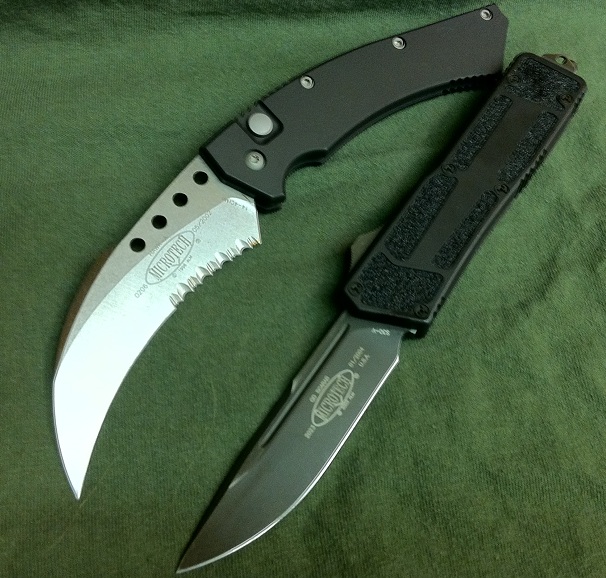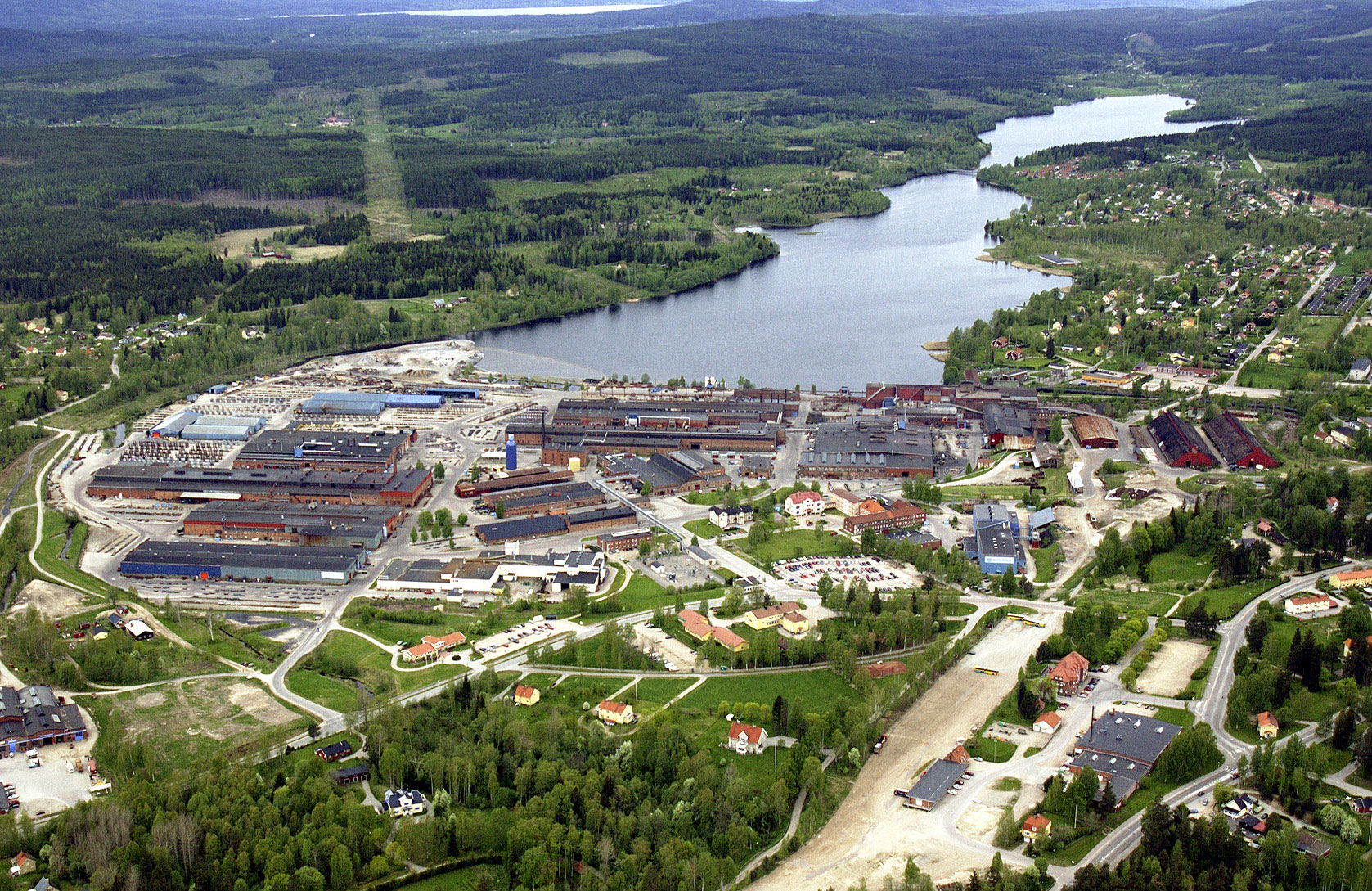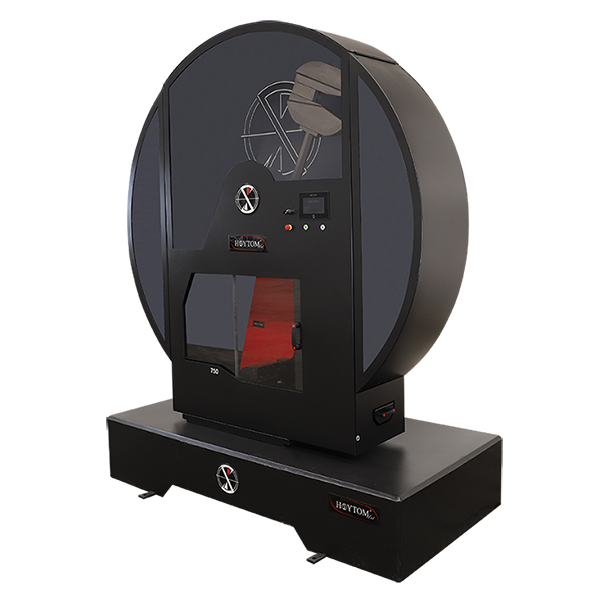|
S30V
CPM S30V is a martensitic (hardened) powder-made (sintered) wear and corrosion resistant stainless steel developed by Dick Barber of Crucible Industries in collaboration with knifemaker Chris Reeve. Its chemistry promotes the formation and even distribution of vanadium carbides, which are harder and more effective at cutting than chromium carbides. These vanadium carbides give the steel a very refined grain, further improving the sharpness and toughness. Despite some difficulties with a consistent heat-treat, knifemakers use CPM S30V because its composition makes it easier to grind than other powder steels although the carbides still wear down the grinder belts considerably. It contains carbon 1.45%, chromium 14.00%, vanadium 4.00%, and molybdenum 2.00%. Barber received feedback from a number of other knife users and knifemakers such as Sal Glesser, Ernest Emerson, Tony Marfione, Phil Wilson, William Harsey Jr., Tom Mayo, Jerry Hossom, and Paul Bos in the development of ... [...More Info...] [...Related Items...] OR: [Wikipedia] [Google] [Baidu] |
Crucible Industries
Crucible Industries, commonly known as Crucible, is an American company which develops and manufactures specialty steels, and is the sole producer of Crucible Particle Metallurgy (CPM) steels. The company produces high speed, stainless and tool steels for the automotive, cutlery, aerospace, and machine tool industries. Crucible's history spans over 100 years, and the company inherited some of its ability to produce high-grade steel from England beginning in the late 1800s. Thirteen crucible-steel companies merged in 1900 to become the largest producer of crucible steel in the United States, and this company evolved into a corporation with 1,400 employees in several states. Crucible declined in tandem with the automotive industry during the 1980s, recovering over the next decade. Although the company entered bankruptcy in 2009, JP Industries of Cleveland revived it as Crucible Specialty Metals Division to continue producing specialty steels at its original site. Some of Crucible ... [...More Info...] [...Related Items...] OR: [Wikipedia] [Google] [Baidu] |
Chris Reeve Knives
Chris Reeve Knives is an American knife manufacturing corporation with international sales and distribution headquartered in Boise, Idaho, that designs, develops, and sells folding pocket knives and fixed-blade knives. Its products include the Sebenza, Inkosi, Umnumzaan, TiLock, Mnandi folding knives, Impinda slip joint, and the Green Beret, Pacific, Professional Soldier, Nyala, and Sikayo fixed blade knives. Chris Reeve Knives' industry contributions include the Integral Lock, contributions to the blade steels CPM-S30V and CPM-S35VN, and has won Blade Magazine's Blade Show Manufacturing Quality Award 15 times. Their motto is ''Think Twice, Cut Once.'' History Chris Reeve Knives was founded as a sole proprietorship in January 1984, with Chris Reeve making custom knives in the single garage attached to the house in which Reeve was living in Durban, South Africa. In March 1989, Reeve and his wife Anne Reeve immigrated to the United States, and CRK commenced manufacturing in Bois ... [...More Info...] [...Related Items...] OR: [Wikipedia] [Google] [Baidu] |
Spyderco
Spyderco is an American cutlery company based in Golden, Colorado, producing knives and knife sharpeners. Spyderco pioneered many features that are now common in folding knives, including the pocket clip, serrations, and the opening hole. Spyderco has collaborated with 30 custom knife makers, athletes, and self-defense instructors for designs and innovated the usage of 20 different blade materials. History Spyderco was founded by Sal Glesser. The name Spyderco was coined after Glesser noticed that many high performance sports cars had 'Spyder' in the name; which inspired the name Spyderco to signify high performance cutting tools. The first product Spyderco produced was the Portable Hand in 1976, this "spider-shaped device", was a series of angles, ball joints and alligator clips that helped people such as jewelers and hobbyists to work with small parts. Spyderco's founder, Sal Glesser, and his wife Gail, converted an old bread delivery truck into a motor-home and traveled to s ... [...More Info...] [...Related Items...] OR: [Wikipedia] [Google] [Baidu] |
CPM VS Conventional
CPM may refer to: Advertising *Cost per mille, the advertising cost per thousand views *Cost per thousand impressions, the online advertising equivalent Management *Certified practising marketer, a qualification for Australian marketers *Certified Property Manager *Certified Public Manager *Comparable Profits Method, a commonly used transfer pricing method for managing internal sales between two divisions of the same company *Corporate performance management is another name for business performance management used in Gartner reports on software systems * Critical path method, an algorithm for scheduling project activities Organizations Asia *The Pentecostal Mission (formerly ''Ceylon Pentecostal Mission''), Sri Lanka *Communist Party of India (Marxist) *Communist Party of Malaya, the Malayan Communist Party Europe *Coalition for Melilla ( es, Coalición por Melilla, links=no), a political party in Melilla *Party of Communists of the Republic of Moldova *Congregatio Presbyterorum ... [...More Info...] [...Related Items...] OR: [Wikipedia] [Google] [Baidu] |
Buck Knives
Buck Knives is an American knife manufacturer founded in Mountain Home, Idaho and now located in Post Falls, Idaho. The company has a long history through five generations of the Buck family from 1902 to the present day. Buck Knives primarily manufactures sport and field knives and is credited with inventing the "folding hunting knife" and popularizing it to such a degree that the term "buck knife" has become synonymous with folding lockback knives, including those made by other manufacturers. History Company origins Hoyt H. Buck became a blacksmith's apprentice in Kansas in 1899 at the age of 10. He learned to make knives and at 13, in 1902, developed a method to heat-treat steel for hoes and other tools so that they would hold an edge longer. Hoyt left Kansas in 1907 for the American northwest and eventually enlisted in the United States Navy. He made his first knife in 1902 in Mountain Home, Idaho. Hoyt made each knife by hand, using worn-out file blades as raw material. Coll ... [...More Info...] [...Related Items...] OR: [Wikipedia] [Google] [Baidu] |
Microtech Knives
Microtech Knives, Inc. is a knife manufacturing company, famous for its automatic knives, that was founded in Vero Beach, Florida in 1994, and operated there until relocating to Bradford, Pennsylvania in 2005 and to Fletcher, North Carolina in 2009. The company expanded the location of its Corporate Headquarters in nearby Mills River, NC in 2018. Microtech now has two active manufacturing factories and one corporate headquarters location. The company has long promoted itself as stressing quality with regard to tight machining tolerances, to within one thousandth of an inch (0.001"). Microtech has designed knives for use by the US Military such as the HALO, UDT, SOCOM and Currahee models. Custom knifemakers, such as Greg Lightfoot have remarked that these tolerances are what makes the factory knives so close to the custom design: "It has the same quality as a handmade custom." Although Microtech has produced many styles of blades in the past such as kitchen knives, fishing kni ... [...More Info...] [...Related Items...] OR: [Wikipedia] [Google] [Baidu] |
Elmax Steel
Uddeholms AB is a multinational producer of high alloyed tool steel with production in Hagfors, Sweden. Since 1991, the company is part of the Austrian Böhler-Uddeholm group which in turn is part of the voestalpine AG group since 2007. Uddeholms AB has 800 Swedish and 3,000 total employees. History The company was founded in 1668 by Bengt Gustaf Geijer. The company was then privately held until 1870 when it became a public company named Uddeholms AB. During the second half of the 19th century, the company introduced electricity and railways to their production. The Uddeholm railway was the first private railway in Sweden and also one of the first to be electrified in 1920. The company was introduced to the United States in the 1830s and in the 1920s a modern international sales organization was created. In 1945, Associated Swedish Steel was created together with four other major Swedish steel producers to sell steel to the new markets in South America, Africa, Middle East ... [...More Info...] [...Related Items...] OR: [Wikipedia] [Google] [Baidu] |
Charpy Impact Test
In materials science, the Charpy impact test, also known as the Charpy V-notch test, is a standardized high strain rate test which determines the amount of energy absorbed by a material during fracture. Absorbed energy is a measure of the material's notch toughness. It is widely used in industry, since it is easy to prepare and conduct and results can be obtained quickly and cheaply. A disadvantage is that some results are only comparative. The test was pivotal in understanding the fracture problems of ships during World War II. The test was developed around 1900 by S. B. Russell (1898, American) and Georges Charpy (1901, French). The test became known as the Charpy test in the early 1900s due to the technical contributions and standardization efforts by Charpy. History In 1896, S. B. Russell introduced the idea of ''residual fracture energy'' and devised a pendulum fracture test. Russell's initial tests measured un-notched samples. In 1897, Frémont introduced a test to ... [...More Info...] [...Related Items...] OR: [Wikipedia] [Google] [Baidu] |
Niobium
Niobium is a chemical element with chemical symbol Nb (formerly columbium, Cb) and atomic number 41. It is a light grey, crystalline, and ductile transition metal. Pure niobium has a Mohs hardness rating similar to pure titanium, and it has similar ductility to iron. Niobium oxidizes in Earth's atmosphere very slowly, hence its application in jewelry as a hypoallergenic alternative to nickel. Niobium is often found in the minerals pyrochlore and columbite, hence the former name "columbium". Its name comes from Greek mythology: Niobe, daughter of Tantalus, the namesake of tantalum. The name reflects the great similarity between the two elements in their physical and chemical properties, which makes them difficult to distinguish. English chemist Charles Hatchett reported a new element similar to tantalum in 1801 and named it columbium. In 1809, English chemist William Hyde Wollaston wrongly concluded that tantalum and columbium were identical. German chemist Heinrich Rose determin ... [...More Info...] [...Related Items...] OR: [Wikipedia] [Google] [Baidu] |
Elastic Modulus
An elastic modulus (also known as modulus of elasticity) is the unit of measurement of an object's or substance's resistance to being deformed elastically (i.e., non-permanently) when a stress is applied to it. The elastic modulus of an object is defined as the slope of its stress–strain curve in the elastic deformation region: A stiffer material will have a higher elastic modulus. An elastic modulus has the form: :\delta \ \stackrel\ \frac where stress is the force causing the deformation divided by the area to which the force is applied and strain is the ratio of the change in some parameter caused by the deformation to the original value of the parameter. Since strain is a dimensionless quantity, the units of \delta will be the same as the units of stress. Specifying how stress and strain are to be measured, including directions, allows for many types of elastic moduli to be defined. The three primary ones are: # ''Young's modulus'' (E) describes tensile and compressive ... [...More Info...] [...Related Items...] OR: [Wikipedia] [Google] [Baidu] |
Molybdenum
Molybdenum is a chemical element with the symbol Mo and atomic number 42 which is located in period 5 and group 6. The name is from Neo-Latin ''molybdaenum'', which is based on Ancient Greek ', meaning lead, since its ores were confused with lead ores. Molybdenum minerals have been known throughout history, but the element was discovered (in the sense of differentiating it as a new entity from the mineral salts of other metals) in 1778 by Carl Wilhelm Scheele. The metal was first isolated in 1781 by Peter Jacob Hjelm. Molybdenum does not occur naturally as a free metal on Earth; it is found only in various oxidation states in minerals. The free element, a silvery metal with a grey cast, has the sixth-highest melting point of any element. It readily forms hard, stable carbides in alloys, and for this reason most of the world production of the element (about 80%) is used in steel alloys, including high-strength alloys and superalloys. Most molybdenum compounds have low solubili ... [...More Info...] [...Related Items...] OR: [Wikipedia] [Google] [Baidu] |
Vanadium
Vanadium is a chemical element with the symbol V and atomic number 23. It is a hard, silvery-grey, malleable transition metal. The elemental metal is rarely found in nature, but once isolated artificially, the formation of an oxide layer ( passivation) somewhat stabilizes the free metal against further oxidation. Spanish scientist Andrés Manuel del Río discovered compounds of vanadium in 1801 in Mexico by analyzing a new lead-bearing mineral he called "brown lead". Though he initially presumed its qualities were due to the presence of a new element, he was later erroneously convinced by French chemist Hippolyte Victor Collet-Descotils that the element was just chromium. Then in 1830, Nils Gabriel Sefström generated chlorides of vanadium, thus proving there was a new element, and named it "vanadium" after the Scandinavian goddess of beauty and fertility, Vanadís (Freyja). The name was based on the wide range of colors found in vanadium compounds. Del Rio's lead mineral was ... [...More Info...] [...Related Items...] OR: [Wikipedia] [Google] [Baidu] |


.jpg)




